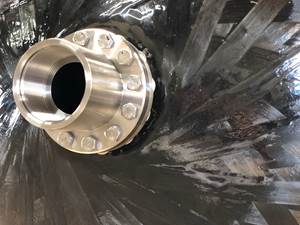From the Publisher - 3/1/2008
I just attended COMPOSITESWORLD’s first Composites Industry Financial Forum (CIF) in New York City, where composites industry, M&A and banking specialists and a Merrill Lynch analyst — in a show of notable accord — agreed that we will see unprecedented opportunities for growth in the use of composites during the
I just attended COMPOSITESWORLD’s first Composites Industry Financial Forum (CIF) in New York City, where composites industry, M&A and banking specialists and a Merrill Lynch analyst — in a show of notable accord — agreed that we will see unprecedented opportunities for growth in the use of composites during the next decade. Aerospace, of course, is setting the pace with net orders for 2,764 commercial aircraft in 2007, many coming from growing Asian markets. American air carriers haven’t even weighed in yet, but as they become more profitable (which they are) and their fleets age, they will want newer, more efficient, lower-maintenance, double-aisle aircraft.
Trevor Bohn from RSM Equico Capital Markets (Costs Mesa, Calif.) pointed out that acceptance of composite materials is fueling M&A activity, and he asserted that projects that require from $50 million to as much as $150 million will find funding, despite the tight credit market. A strong case was made for continuous growth in the next 20 years: After the Boeing 787 and forthcoming Airbus A350, all future aircraft will use increasing amounts of structural composites — not only large passenger planes but also regional/business jets and general aviation aircraft as well as jet engines, said Chris Red, an HPC contributing writer and VP of Market Research for Composites Market Reports (Scottsdale, Ariz.). Meanwhile, high fuel costs and demand for greener, more efficient engines will require replacement of workhorse single-aisle planes — Boeing’s 737 and the Airbus A320 — for which new designs will be ready around 2015-2017. Kevin Michaels (Aerostrategy, Ann Arbor, Mich.) valued airframe production in all markets (including engines and MRO services) at around $125 billion in 2006 and predicted that figure will double by 2026.
Brian C. Yerger, research analyst at Jesup and Lamont Capital Markets (New York, N.Y.), estimated that by 2010, revenue directly related to alternative energy applications, such as wind turbine blades and pressurized natural gas and hydrogen fuel tanks, will be $1.08 billion for carbon fiber at $16/lb and $1.45 billion for fiberglass at $3/lb. He emphasized that usage will not be cyclical and that the market for investment will become increasingly favorable as governments and their citizens up their demand for cleaner energy.
Len Poveromo of Northrop Grumman (Beth Page, N.Y.) discussed lessons learned on the U.S. Navy’s Zumwalt-class DDG 1000 destroyer, for which Bath Iron Works has received a $1.4 billion construction contract. Although they are extensively used in boatbuilding elsewhere, composites have been a long time coming to Navy vessels. However, Poveromo says they are finally earning their way on board in the antenna (the large deckhouse structure) on the DDG at nearly a million lb per copy, and he says the Navy is considering them for the antennae on the next generation CVN-X aircraft carrier.
In the midst of these opportunities, however, CIF speakers noted challenges. The consensus is that fiber supply is growing rapidly to meet demand, but parts manufacturers will need to add capacity and automate to produce the expected high volumes. Ed Carson, COO of HITCO Carbon Composites (Gardena, Calif.), explained how his company’s in-depth analysis of market trends convinced it that investing in automation was a necessary strategy (see this issue’s feature on HITCO’s transformation by clicking on “Automate or Emigrate,” in Related Content, at left). And Jim Mondo, president of Automated Dynamics (Schenectady, N.Y.) provided very practical advice about some affordable automated machinery options and strategies.
Paul Pendorf, president of AMT ll Corp. (Los Angeles, Calif.), emphasized that it is always difficult for a new material to gain acceptance. “The benefits of composites substitution for metal are not intuitively obvious to the layman,” he noted, nor are they clear to busy investment bankers, analysts, brokers or congressmen. His advice? Don’t over explain: what we’re about is metal replacement.
CIF facilitated a valuable exchange between companies who are bringing our exceptional technologies to market and the companies who will help us raise the money to make it happen. I hope to see you there next year.
Related Content
Infinite Composites: Type V tanks for space, hydrogen, automotive and more
After a decade of proving its linerless, weight-saving composite tanks with NASA and more than 30 aerospace companies, this CryoSphere pioneer is scaling for growth in commercial space and sustainable transportation on Earth.
Read MoreSRI develops scalable, infiltration-free ceramic matrix composites
Work in two DOE projects is demonstrating C/C-SiC produced in 3-5 days with <5% shrinkage, <10% porosity and 50% the cost of conventional C/C and C/C-SiC.
Read MoreWe4Ce infused 2.5-3-MW rotor blade design passes validation test
Composite rotor blade structure design by We4Ce, mold and prototype production by InDutch Composites and fatigue testing by Suzlon Group has resulted in the novel blade’s IEC61400-5:2020 certification.
Read MoreRevolutionizing space composites: A new era of satellite materials
A new approach for high volumes of small satellite structures uses low-CTE, low-cost CFRP cellular core, robust single-ply skins and modular panel systems to cut lead time, labor and cost for reflectors, solar arrays and more.
Read MoreRead Next
Ultrasonic welding for in-space manufacturing of CFRTP
Agile Ultrasonics and NASA trial robotic-compatible carbon fiber-reinforced thermoplastic ultrasonic welding technology for space structures.
Read MoreScaling up, optimizing the flax fiber composite camper
Greenlander’s Sherpa RV cab, which is largely constructed from flax fiber/bio-epoxy sandwich panels, nears commercial production readiness and next-generation scale-up.
Read MoreCutting 100 pounds, certification time for the X-59 nose cone
Swift Engineering used HyperX software to remove 100 pounds from 38-foot graphite/epoxy cored nose cone for X-59 supersonic aircraft.
Read More








